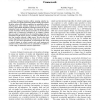62 search results - page 12 / 13 » Biological Metaphors for Agent Behavior |
APIN
2006
13 years 5 months ago
2006
Biologists are building increasingly complex models and simulations of cells and other biological entities, and are looking at alternatives to traditional representations. Making ...
ICRA
2009
IEEE
14 years 4 days ago
2009
IEEE
Abstract— Biological systems achieve amazing adaptive behavior with local agents performing simple sensing and actions. Modular robots with similar properties can potentially ach...
GECCO
2004
Springer
13 years 11 months ago
2004
Springer
Extending the notion of inheritable genotype in genetic programming (GP) from the common model of DNA into chromatin (DNA and histones), we propose an approach of embedding in GP a...
NECO
2007
13 years 5 months ago
2007
Learning agents, whether natural or artificial, must update their internal parameters in order to improve their behavior over time. In reinforcement learning, this plasticity is ...
BMCBI
2008
13 years 5 months ago
2008
Background: In gene expression analysis, statistical tests for differential gene expression provide lists of candidate genes having, individually, a sufficiently low p-value. Howe...

